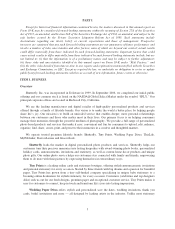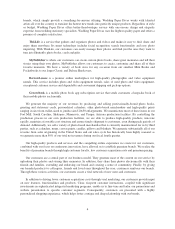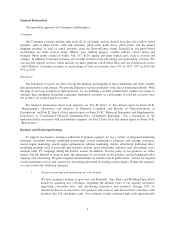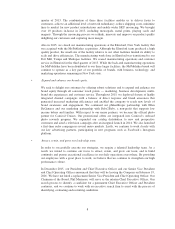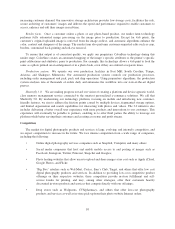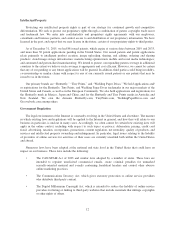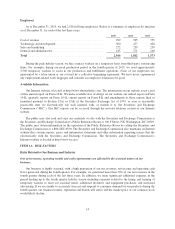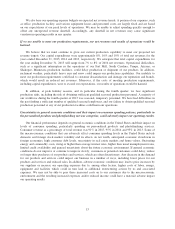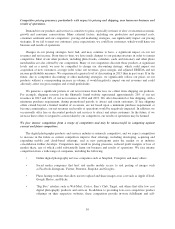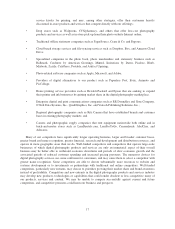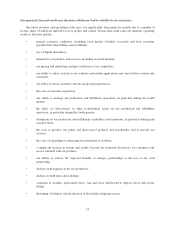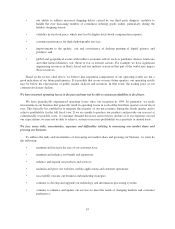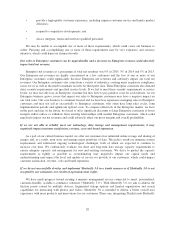Shutterfly 2015 Annual Report Download - page 12
Download and view the complete annual report
Please find page 12 of the 2015 Shutterfly annual report below. You can navigate through the pages in the report by either clicking on the pages listed below, or by using the keyword search tool below to find specific information within the annual report.increasing customer demand. Our innovative storage architecture provides low storage costs, facilitates the safe,
secure archiving of customers’ images and delivers the speed and performance required to enable customers to
access, enhance and edit their images in real-time.
Render farm. Once a customer orders a photo or any photo-based product, our render farm technology
performs fully automated image processing on the image prior to production. Except for 4x6 prints, the
customer’s original uploaded image is retrieved from the image archive, and automatic algorithms enhance the
color, contrast and sharpness of the image. The render farm also performs customer-requested edits such as crop,
borders, customized back-printing and red-eye removal.
To ensure that output is of consistent quality, we apply our proprietary ColorSure technology during this
render stage. ColorSure creates an automated mapping of the image’s specific attributes to the printer’s specific
print calibrations and attributes, prior to production. For example, this technology allows a 4x6 print to look the
same as a photo printed on an enlargement or in a photo book, even if they are ordered at separate times.
Production system. We operate our own production facilities in Fort Mill, South Carolina; Tempe,
Arizona; and Shakopee, Minnesota. Our automated production system controls our production processes,
including order management and pick, pack and ship operations. Using proprietary algorithms, the production
system analyzes tens of thousands of orders daily and automates the workflow into our state-of-the-art digital
presses.
Shutterfly 3.0. We are making progress toward our vision of creating a platform and device agnostic world-
class memory management service connected to the smartest personalized e-commerce solutions. We call that
Shutterfly 3.0. By modernizing our technology platform, focusing on mobile and introducing new customer-
friendly features, we aim to address the friction points caused by multiple devices, fragmented storage options,
and limited organization and search capabilities for interacting with photos and videos. The 3.0 initiative also
includes delivering a better overall user experience with more products and innovations to our customers. This
experience will eventually be portable to partners, enabling us to offer third parties the ability to leverage our
platform while better serving their customers and creating a revenue and profit stream.
Competition
The market for digital photography products and services is large, evolving, and intensely competitive, and
we expect competition to increase in the future. We face intense competition from a wide range of companies,
including the following:
• Online digital photography services companies such as Snapfish, Vistaprint, and many others;
• Social media companies that host and enable mobile access to and posting of images such as
Facebook, Instagram, Twitter, Pinterest, Snapchat and Google+;
• Photo hosting websites that allow users to upload and share images at no cost such as Apple iCloud,
Google Photos, and Flickr;
• “Big Box” retailers such as Wal-Mart, Costco, Sam’s Club, Target, and others that offer low cost
digital photography products and services. In addition to providing low-cost competitive product
offerings on their respective websites, these competitors provide in-store fulfillment and self-
service kiosks for printing, and may, among other strategies, offer their customers heavily
discounted in-store products and services that compete directly with our offerings;
• Drug stores such as Walgreens, CVS/pharmacy, and others that offer low-cost photography
products and services as well as in-store pick-up from their photo website Internet orders;
10





